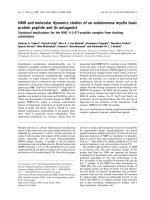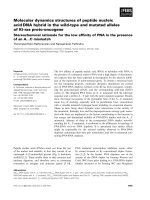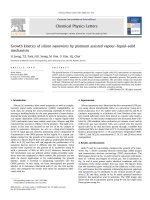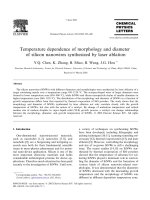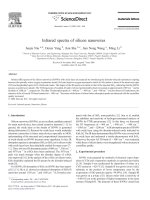- Trang chủ >>
- Khoa Học Tự Nhiên >>
- Vật lý
Molecular dynamics simulations of the tensile and melting behaviours of silicon nanowires
Bạn đang xem bản rút gọn của tài liệu. Xem và tải ngay bản đầy đủ của tài liệu tại đây (711.88 KB, 5 trang )
Molecular dynamics simulations of the tensile and melting behaviours of
silicon nanowires
Yuhang Jing
Ã
, Qingyuan Meng, Wei Zhao
Department of Astronautical Science and Mechanics, Harbin Institute of Technology, No.92, West Da-Zhi Street, Harbin 150001, People’s Republic of China
article info
Article history:
Received 29 September 2008
Received in revised form
7 November 2008
Accepted 13 November 2008
Available online 3 December 2008
PACS:
61.46.Km
62.25.Àg
65.80.+n
Keywords:
Si nanowires
Molecular dynamics
Tension
Melting behaviour
abstract
The tensile and melting behaviours of single crystalline silicon nanowires (SiNWs) are studied using
molecular dynamics simulations. The atomic interactions are described using the Stillinger–Weber
potential. The tensile test results show that the tensile behaviour of the SiNWs is strongly dependent on
the simulation temperature, strain rate, and diameter of the nanowires. The critical load clearly
decreases with increasing temperature and with decreasing strain rate, and increases with increasing
diameter. Additionally, the melting test results demonstrate that the melting temperature of the SiNWs
decreases with decreasing diameter, due to the increase in surface energy. The structural transition of
SiNWs with an increasing temperature is also studied.
Crown Copyright & 2009 Published by Elsevier B.V. All rights reserved.
1. Introduction
One-dimensional semiconductor nanostructures are attracting
great interest for their tremendous technological potential in
nanoscale devices [1,2]. Utilizing the structure at the nanometer
level is a key technology in the development of electronic devices
and elements of nanoelectromechanical systems (NEMS). There-
fore, it is important to understand the mechanical properties for
engineering usefulness such as design of reliability in service.
Silicon nanowires (SiNWs) appear to be an especially appealing
choice due to their compatibility with conventional Si-based
electronic technology. Recently, SiNWs have been synthesized by
solution techniques [3], an oxide-assisted catalyst-free method
[4,5], and a metal-catalytic vapour–liquid–solid method [6–8].
High-resolution electron microscopy experiments have shown
that the resulting SiNWs carry cores with monocrystalline bulk
structures [7,9].
From a theoretical viewpoint, many correlative theoretical
predictions have been performed in recent years [10–15]. In most
of the work, the Quantum mechanics methods were used, and the
attentions were mainly paid on the microstructural and electronic
properties of the SiNWs. The mechanical strength of the nanowires
plays an important role in maintaining the structural integrity of
the structures, devices or systems. However, such calculations are
very expensive. Sizedependent and thermodynamical properties of
nanowires are still unattainable to such methods. Molecular
dynamics (MD) simulations are increasingly being used to study
the mechanical behaviour and deformation mechanisms of
nanostructures. A number of studies have used the MD simula-
tions to analyze the tensile failure modes in metal nanowires
[16–19]. Metal nanowires have been found to exhibit unique
physical behaviour under tensile loading. However, the studies on
the mechanical characters of SiNWs are little reported [20,21].
Although empirical methods carry a considerable simplification of
the underlying atomistic processes, they still represent an
alternative to access those important nanowire properties [20,22].
In this paper, we report the results of MD simulations on
the tensile and melting behaviours of [110]-oriented SiNWs. The
effect of temperature, strain rate, and cross-sectional size on
the mechanical properties is studied. We also investigate the size
effect on the melting temperature of SiNWs.
2. Simulation method
Because the exact atomic structure of the SiNWs is unknown in
most cases, some theoretical calculations of nanowires with
different shapes can be found in the literature. Zhao and Yakobson
ARTICLE IN P RESS
Contents lists available at ScienceDirect
journal homepage: www.elsevier.com/locate/physe
Physica E
1386-9477/$ -see front matter Crown Copyright & 2009 Published by Elsevier B.V. All rights reserved.
doi:10.1016/j.physe.2008.11.006
Ã
Corresponding author. Tel.: +86 451864 00158.
E-mail address: (Y. Jing).
Physica E 41 (2009) 685–689
[23] proposed the pentagonal and hexagonal SiNWs along the
/110S direction. Justo et al. [24] reported classical molecular
dynamic simulations of silicon nanowires of various shapes and
orientations. Menon [20] and Ponomareva et al. [22] investigated
the tetragonal and clathrate SiNWs. Based on the reported
experimental observation [9], the triangular-shaped nanowires
have relatively large size (diameter of about 100 nm). As for the
triangular-shaped SiNWs, no theoretical study has been reported
in the literature. A detailed study of such SiNWs is necessary to
understand the properties of SiNWs with different shapes. In this
study, we construct [110]-oriented SiNWs with triangular cross
sections directly from the bulk silicon by removing the atoms
outside a triangle. To save computational time, the NWs are
relatively thin with diameter Do10 nm, the top and side views of
the optimized structures of single crystalline SiNWs are shown in
Fig. 1. The nanowires with triangular cross-sectional shape are
enclosed with two {111} side planes and one {10 0} side plane.
The atomic interactions are described using the Stillinger–
Weber (SW) potential [25]. The empirical SW interatomic
potential consists of two- and three-body interaction terms and
were originally fitted to describe the crystalline and liquid silicon
phases. This potential consists of sums of two- and three-body
interaction contributions. The two-body potential describes the
formation of a chemical bond between two atoms. The three-body
potential favors structures in which the angles between two
bonds made by the same atom are close to the tetrahedral angle.
The SW potential has been used in the study of molten Si [25] as
well as surfaces of crystalline Si [26]. The SW potential has also
been adopted for the study of SiNWs and found to give good
results for nanowire properties [20,22]. Therefore, the SW
potential should be reliable to study the mechanical properties
of SiNWs.
The loading state in the present tension simulations is as
follows: the relative positions of atoms within the five atomic
layers at the top and bottom of NWs are fixed during simulations,
forming two rigid borders; the others are set as thermal controlled
layers, as illustrated in Fig. 1. The system temperature is controlled
by rescaling the atom velocities [27]. The SiNWs are initially
annealed at 700 K over a period of 10
6
time-steps, where each step
is separated by an interval of 0.5 fs, and then the structures of the
nanowires were dynamically relaxed at a given temperature for
50 ps with traction-free boundary conditions, which allows the
nanowires to have stable configuration. The strain was then
applied along the axial direction to study the mechanical proper-
ties of the SiNWs. In order to investigate the relative influences of
temperature, strain rate and cross-sectional size on the mechan-
ical properties of the current SiNWs under tension loading
conditions, this study simulates testing under various tempera-
tures in the range of 10–1200 K, with strain rates varying from
2 Â 10
À4
to 2 Â 10
À2
/ps and wire diameter ranging from 4.27 to
6.15 nm. In the melting simulations, the periodic boundary
condition is applied in the axial direction. The initial configuration
was relaxed for 50ps at 300 K. The heating process is simulated by
a temperature increment of T ¼ 100 K. However, a temperature
increment of T ¼ 50 K is applied near the melting region. For each
temperature interval, the MD cell was relaxed for 50 ps.
3. Results and discussion
The generated results of the MD simulation are presented. The
deformation characteristics of the nanowire in uniaxial tension
are considered at the first stage. The effect of temperature, strain
rate, and cross-sectional size on the mechanical properties of the
nanowires such as the critical load is studied. Afterwards, the
melting properties of the SiNWs are investigated.
3.1. The tensile properties of the SiNWs
Fig. 2(a) shows the axial load–strain curve for the SiNW with
diameter 4.27 nm, simulated at 300 K, with strain rate of 0.04%/ps.
From the figure, it is seen that the load increases up to a
maximum value of 141 nN corresponding to strain of 0.124, then
the load suddenly decreases to 32 nN where the plastic zone is
developed. For low strains (
e
o0.05), the load–strain relation
is essentially linear in the elastic regime, and Young’s modulus can
be directly evaluated in this elastic region. Young’s modulus is
ARTICLE IN PRESS
Fig. 1. Top and side views of the optimized structures of single crystalline SiNWs.
Fig. 2. (a) Load–strain curves of the SiNW with diameter 4.27 nm, simulated at
300 K, with strain rate of 0.04%/ps. (b) Snapshots of atomic configurations at
various strains.
Y. Jing et al. / Physica E 41 (2009) 685–689686
estimated as 118.4 GPa according to the present model, which is
consistent with the experimental result of 93–180 GPa of SiNWs
[28,29]. The deformation process can be better understood by the
wire evolution presented in Fig. 2(b). For small strains, the bonds
of the nanowire are just stretched and preserve their fourfold
coordination in the nanowire, and no structural defects appear at
this stage. For larger strains, bond breakage in the outmost layer is
observed and spreads toward the center as the strain increases.
With the strain increasing further more, we find that sliding along
the {111} plane happens, and many atoms rearrange in the neck
region. When a single crystal is stretched, the fundamental
deformation mechanism is a shearing action based on the
resolved shear stress on an active slip system. The silicon is a
diamond structure and its slip plane is {111} [30], and in the
present simulation the load is along the [11 0] orientation and the
resolved shear stress on the (111) plane causes the sliding. After
the formation of the neck, the plastic deformations have been
carried mainly through the reconstruction and rearrangement of
the neck region, which was previously reported in other studies
[16]. Beyond this region, the nanowire keeps ordered structure
and have no significant change.
Since buckling occurs as a result of dynamic processes, the
mechanisms of material deformation are influenced both by
temperature and by strain rate. Therefore, if material deforma-
tions in SiNWs are to be fully understood, the influences of these
factors must be investigated. Fig. 3 shows the effects of
temperature and strain rate on the tension behaviour. Fig. 3(a)
shows the axial load–strain curves of SiNWs with diameter
4.27 nm, which were simulated at 10–1200 K with a strain rate of
0.04%/ps. The results clearly demonstrate that the critical buckling
load decreases at higher temperature. At higher temperature, the
atomic structure has high entropy, and the atoms vibrate about
their equilibrium position at much larger amplitude. A greater
number of molecules gain sufficient energy to overcome the
activation energy barrier, as compared to low temperature, and
hence deformation occurs. This result suggests that a thermally
activated process plays an activating role in the complete
elongation of SiNWs. Fig. 3(b) shows the axial load–strain curves
of SiNWs with diameter 4.27 nm, which were simulated at 300 K
with strain rate varying from 0.02 to 2%/ps. The strain rate
adopted here is very high compared to that in experiment,
because only very short period of time can be simulated due to the
time scale of molecular dynamics set by the atomic motion. One
consequence of the short time scale is that very high strain rates
are required to get any reasonable deformation within the
available time [31]. For all strain rates, the load increases linearly
with strain up to 0.11. Below this value, the load–strain curves are
almost completely overlapped for all of strain rates applied,
indicating that in the linear elastic region no plastic deformation
occurs and the elastic properties of a nanowire is insensitive to
strain rate. However, a slower strain rate results in a lower critical
buckling load. Regarding the strain rate influence, the strain or
deformation tends not to be uniformly distributed within the
material, particularly when a large strain is applied. Hence, some
regions of the nanowire are subjected to larger stresses or strains
than others, and it is within these regions that defects will first
become evident. When a lower strain rate is applied, the SiNWs
have more time to induce adequate local deformation, and hence
the onset of plastic deformation is accelerated. Therefore, a slower
strain rate results in a lower critical load. The present results
clearly demonstrate that the mechanical properties of SiNWs are
sensitive to the strain rate and temperature conditions.
An important factor in evaluating the mechanical properties of
nanowire is the size effect. Physical and chemical properties of
materials are expected to exhibit some dependencies on dimen-
sionality and cross-sectional size. We describe the scaling proper-
ties of nanowires as a function of their diameters (as shown in
Fig. 1). As for the triangular-shaped SiNWs in the present study,
the method to estimate an effective wire size is similar to Ref.
[24], where the perimeter of SiNWs were used to estimate an
effective wire size. To investigate the effect of the SW potential on
the scaling properties of SiNWs, the critical loads are also
computed using the Tersoff potential [32] and EDIP model
[33,34]. The simulation results show that the SW potential seems
to be more reasonable to describe silicon nanowires. Fig. 4(a)
shows the axial load–strain curves for nanowires with diameter
4.27 nm, which were simulated at 300 K with a strain rate of
0.04%/ps. From the picture, it can be seen that the Tersoff potential
shows the highest critical load and critical strain. The SW
potential shows somewhat higher critical load than the EDIP
model, however, the EDIP model shows somewhat higher critical
strain than the SW potential. The critical strain (0.124) computed
using the SW potential is in good agreement with experiment
result (0.104) [35]. The critical loads computed using the three
different interatomic potentials are higher than the experimental
estimates [35]. It should be noted, however, that experimental
samples almost always contain defects and impurities that can
reduce the critical strength. Fig. 4(b) shows the variation in critical
load with diameter of SiNWs. The result clearly demonstrates that
ARTICLE IN P RESS
Fig. 3. Load–strain curves for the SiNWs under tensile loading. Effects of
(a) temperature and (b) strain rate on the tension behaviour of the SiNWs.
Y. Jing et al. / Physica E 41 (2009) 685–689 687
the critical load decreases with decreasing the diameter of the
nanowires. Specifically, as the diameters increase from 4.27 to
6.15 nm, decreases of about 50% in the critical load computed
using the three different interatomic potentials. The reason for
this behaviour may be the small atomic-coordination number and
weak cohesion of the atoms near the surface, as compared with
those in the bulk, and the increasing dominance of the surface
would decrease the strength of the structure.
3.2. The melting properties of the SiNWs
The variation of potential energies as a function of temperature
is shown in Fig. 5. As can be seen from the results in the picture,
the energy generally increases with decreasing diameter of SiNWs
at a given temperature, which indicates that surface energy
increases with decreasing diameter. The potential energies also
increase linearly with increasing temperature and change
abruptly near the melting region. The melting temperature T
m
is
defined as the point of an abrupt change in the potential energies
for the heating process. From Fig. 5, it is found that the melting
temperature of SiNWs increases with increasing diameter, which
is consistent with the fact that the melting behaviour of
nanostructure materials is strongly dependent on size. In general,
the thermodynamic property of nanostructures is different from
bulk materials [36]. The change of the melting temperature of
nanostructures depends on their surface. This indicates that the
unstable surface of free-standing nanowires leads to a decrease in
the melting temperature.
To understand the melting behaviour of SiNWs, the structural
evolution of the nanowire with the diameter of 3.32 nm at
different temperatures in the heating process is shown in Fig. 6.
Before the melting behaviour starts, the atoms of the SiNW
oscillate at their equilibrium position. As the melting behaviour
starts, the unstable atoms on the edge move to the facet of the
SiNW. It should be also noted that at 1450 K, which is 150 K below
the melting point, several atoms in the central region of the
nanowires are still in the crystalline configurations. However,
when the temperature is increased to 1600 K, none of the atoms
are in their lattice configurations, and the atomic positions are
ARTICLE IN PRESS
Fig. 4. (a) Load–strain curves for SiNWs with diameter 4.27 nm, which were
simulated at 300 K with strain rate of 0.04%/ps. (b) The variation in critical load
with the diameter of SiNWs.
Fig. 5. Potential energy as a function of temperature for SiNWs.
Fig. 6. Structural transition of the SiNW with a diameter of 3.32nm at different
temperatures.
Y. Jing et al. / Physica E 41 (2009) 685–689688
disordered. The nanowire finally collapses, which indicates the
melting of the nanowire.
4. Conclusions
In this paper, molecular dynamics simulations with Stillin-
ger–Weber potentials are used to simulate the tensile and melting
behaviours of the SiNWs. It is found that the tensile behaviour of
the SiNWs is strongly dependent on the simulation temperature,
strain rate, and diameter of the SiNWs. The critical load clearly
decreases with increasing temperature and with decreasing strain
rate, and increases with increasing diameter. Additionally, it is
observed that the melting temperature of the SiNWs increases
with increasing diameter, due to the surface energy increased.
This indicates that the unstable surface of free-standing nano-
wires leads to a decrease in the melting temperature.
Acknowledgement
This work was supported by the NSF of China under Grant no.
10772062.
References
[1] A.M. Morales, C.M. Lieber, Science 279 (1998) 208.
[2] C.M. Lieber, Nano Lett. 2 (2002) 81.
[3] J.D. Holmes, K.P. Johnston, R.C. Doty, et al., Science 287 (2000) 1471.
[4] Y.F. Zhang, Y.H. Tang, N. Wang, et al., Appl. Phys. Lett. 72 (1998) 1835.
[5] N. Wang, Y.F. Zhang, Y.H. Tang, et al., Appl. Phys. Lett. 73 (1998) 3902.
[6] Y. Cui, L.J. Lauhon, M.S. Gudiksen, et al., Appl. Phys. Lett. 78 (2001) 2214.
[7] Y. Wu, Y. Cui, L. Huynh, et al., Nano Lett. 4 (2004) 433.
[8] J. Kikkawa, Y. Ohno, S. Takeda, Appl. Phys. Lett. 86 (2005) 123109.
[9] Chi-Pui Li, Chum-Sing Lee, Xiu-Liang Ma, et al., Adv. Mater. 15 (2003) 607.
[10] R. Kagimura, R.W. Nunes, H. Chacham, Phys. Rev. Lett. 95 (2005) 115502.
[11] R. Rurali, N. Lorente, Nanotechnology 16 (2005) S250.
[12] R. Rurali, A. Poissier, N. Lorente, Phys. Rev. B 74 (2006) 165324.
[13] T. Vo, A.J. Williamson, G. Galli, Phys. Rev. B 74 (2006) 045116.
[14] Alexei Svizhenko, Paul W. Leu, Kyeongjae Cho, Phys. Rev. B 75 (2007) 125417.
[15] Pavel B. Sorokin, Pavel V. Avramov, Alexander G. Kvashnin, et al., Phys. Rev. B
77 (2008) 235417.
[16] S.J.A. Koh, H.P. Lee, C. Lu, et al., Phys. Rev. B 72 (2005) 085414.
[17] E.Z. da Silva, A.J.R. da Silva, A. Fazzio, Phys. Rev. Lett. 87 (2001) 256102.
[18] Xiaofan Li, Wangyu Hu, Shifang Xiao, et al., Physica E 40 (2008) 3030.
[19] S.J.A. Koh, H.P. Lee, Nanotechnology 17 (2006) 3451.
[20] M. Menon, D. Srivastava, I. Ponomareva, et al., Phys. Rev. B 70 (2004) 125313.
[21] Paul W. Leu, Alexei Svizhenko, Kyeongjae Cho, Phys. Rev. B 77 (2008) 235305.
[22] I. Ponomareva, M. Menon, D. Srivastava, et al., Phys. Rev. Lett. 95 (2005)
265502.
[23] Y. Zhao, B. Yakobson, Phys. Rev. Lett. 91 (2003) 035501.
[24] J.F. Justo, R.D. Menezes, L.V.C. Assali, Phys. Rev. B 75 (20 07) 045303.
[25] F. Stillinger, T. Weber, Phys. Rev. B 31 (1985) 5262.
[26] F.F. Abraham, I.P. Batra, Surf. Sci. 163 (1985) L752.
[27] H. Andersen, J. Chem. Phys. 72 (1980) 2384.
[28] T. Yi, L. Li, C.J. Kim, Sensor Actuator A 83 (2000) 172.
[29] M. Tabib-Azar, M. Nassirou, R. Wang, et al., Appl. Phys. Lett. 87 (2005) 113102.
[30] J. Godet, L. Pizzagalli, S. Brochard, Phys. Rev. B 70 (2004) 054109.
[31] Yu-Hua Wen, Zi-Zhong Zhu, Ru-Zeng Zhu, Comput. Mater. Sci. 41 (2008) 553.
[32] J. Tersoff, Phys. Rev. B 38 (1988) 9902.
[33] M.Z. Bazant, E. Kaxiras, J.F. Justo, Phys. Rev. B 56 (1997) 8542.
[34] J.F. Justo, M.Z. Bazant, E. Kaxiras, et al., Phys. Rev. B 58 (1998) 2539.
[35] T. Kizuka, Y. Takatani, K. Asaka, et al., Phys. Rev. B 72 (2005) 035333.
[36] W.H. Qi, Physica B 368 (2005) 46.
ARTICLE IN P RESS
Y. Jing et al. / Physica E 41 (2009) 685–689 689
